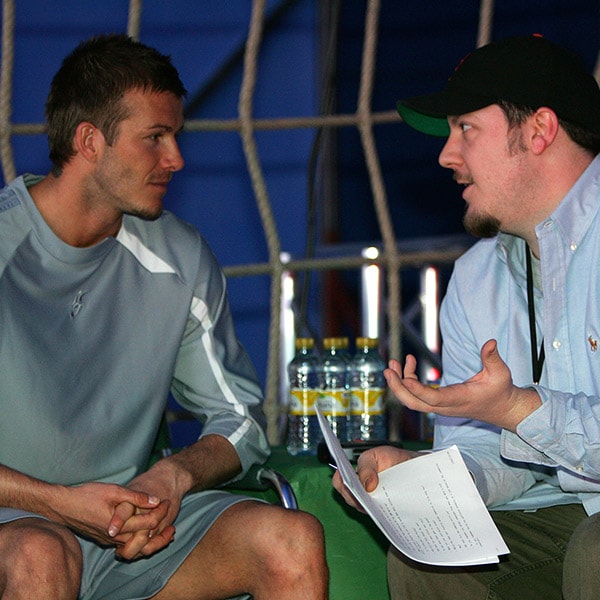Just over a decade ago, I decided that it was time to bet big on soccer. I was working as an editor at SLAM, the world’s leading basketball magazine, and the company that owned us was always looking for different publishing avenues to explore.
I’d been watching early morning and late night soccer from England and Europe for a few years, but it was living in New York City during the 2002 World Cup that convinced me that soccer was coming to the U.S. stay. New York is a city filled with people who’ve moved to the Big Apple not only from across the country, but also from all around the globe, and the one thing everyone seemed to agree on during the summer of 2002 was that soccer was everything.

It took some convincing, but my bosses finally went in and allowed us to launch Striker, America’s ultimate soccer magazine. We immediately found open arms from Nike and adidas, who had these global stars they were trying desperately to market domestically. We quickly got shoots and sit-downs with everyone from Landon Donovan to Patrick Viera to Thierry Henry. I went to Barcelona to run around the pitch at Camp Nou with Ronaldinho, went to Manchester to hang with Tim Howard, had lunch in Madrid with David Beckham (and Posh Spice).
After four issues, we discovered a hard truth: The magazine sold pretty well on newsstands, with each issue selling better and better. But other than the shoe companies, there really weren’t any big companies out there ready to buy ads in our magazine. And while newsstand sales are great and all, magazines do not survive on newsstand sales alone.
Striker died after one year, but soccer in America has continued gaining ground, albeit slowly. The Euro stars that MLS imported may have been aging, but they’ve helped grow the league and the sport. This is totally anecdotal, but I also believe that as more and more people move to this country from soccer-first countries, they’ve brought a love of soccer with them and passed it down to their children. It helps that these days it’s easier than ever to watch soccer—you don’t have to stay up all night to find replays with the announcers doing voiceovers from a closet in Bristol. I don’t think soccer is on the precipice of becoming America’s pastime, but it’s clearly here and not going anywhere anytime soon.
I say all that as a preamble to what I witnessed a few weeks ago here in Memphis, when our new local soccer outlet, 901 FC, kicked off their premiere season. The local baseball stadium had been transformed into a full-on soccer pitch with sign boards and plexiglass-covered benches, one of which blew away during the second half. The field was perhaps a bit patchy in places, but for a minor league team, the setup was a major league effort.
And where soccer can really shine in the States is in the user experience. That night in Memphis, fans lined up to march the streets of downtown and stand throughout the game, banging drums and giving full-throated cheers the entire night. Colored plumes of smoke soared into the sky, as someone smashed an acoustic guitar over an amplifier to commemorate the occasion. My six-year-old son got into the spirit and chanted “Defend Memphis!” although it was unclear if we were actually under attack to begin with.
I don’t really even remember if 901 FC won or lost the game—considering the team has only won 2 of their 12 games, I don’t think we won—but I do remember the experience. I remember the atmosphere and the way all these die-hard 901 FC fans, who hadn’t existed before that day, came together as one to root for their team, which also hadn’t existed before that day. At least here in Memphis, soccer has provided a canvas upon which people are able to build a community. It doesn’t matter that the team isn’t actually winning matches yet, it’s about having a place where like-minded people can meet in the middle.
In retrospect, I bet wrong. Or maybe I didn’t? One decade ago, soccer didn’t immediately blow up to the point where it could sustain a magazine. But a decade later, American soccer culture right now probably could. (You know, if magazines still existed.)
Soccer in America, and in Memphis, is for real. There are 24 teams in MLS, with more coming. Sure, there will always be soccer fans in America who believe the sport isn’t getting enough attention, who wonder why soccer isn’t leading “SportsCenter” or on the front page of the local newspaper. (You know, if newspapers still existed.) Soccer will probably never be as big in America as many of us believe it should be, but when you look today at how far it’s come just over the last decade, it’s impressive.
And isn’t that good enough?
The contents of this page have not been reviewed or endorsed by the Memphis Grizzlies. All opinions expressed by Lang Whitaker are solely his own and do not reflect the opinions of the Memphis Grizzlies or its Basketball Operations staff, owners, parent companies, partners or sponsors. His sources are not known to the Memphis Grizzlies and he has no special access to information beyond the access and privileges that go along with being an NBA accredited member of the media.
